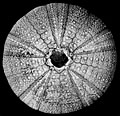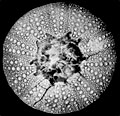The Echinoid Directory
Leioechinus Kier, 1972, p. 48
| Diagnostic Features |
|
|---|---|
| Distribution | Middle Jurassic (Bathonian), Middle East. |
| Name gender | masculine |
| Type | Leioechinus namus Kier, 1972, p. 48 by original designation. |
| Species Included |
|
| Classification and/or Status |
|
| Remarks |
|





